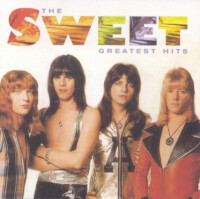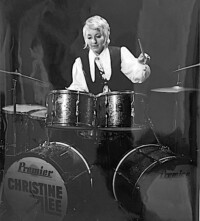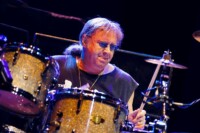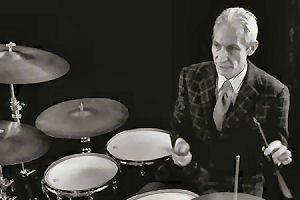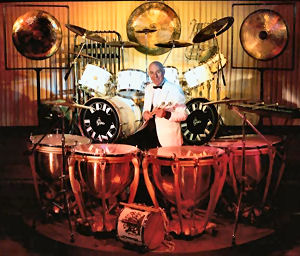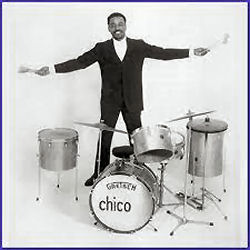 Foreststorne ‘Chico’ Hamilton was born in Los Angeles on September 20th 1921 and I have to admit he didn’t exactly introduce me to jazz; instead he introduced me to something which for me, as an embryonic rock ‘n’ roll drummer, proved to be very important. The possibilities offered by playing a regular drum kit with tympani mallets! I saw him doing exactly this to a piece called ‘Blue Sands’ in the film ‘Jazz On A Summer’s Day’ – and I was captured.
Foreststorne ‘Chico’ Hamilton was born in Los Angeles on September 20th 1921 and I have to admit he didn’t exactly introduce me to jazz; instead he introduced me to something which for me, as an embryonic rock ‘n’ roll drummer, proved to be very important. The possibilities offered by playing a regular drum kit with tympani mallets! I saw him doing exactly this to a piece called ‘Blue Sands’ in the film ‘Jazz On A Summer’s Day’ – and I was captured.
To set the scene everything about his appearance in the film of the 1958 Newport Jazz Festival with his single-headed Gretsch drum set was fabulous. Chico was the epitome of cool from his narrow-shouldered suit, to his tab-collared shirt, the beads of sweat on his brow and the rhythm he was playing on the drums – and last, but certainly not least, his black ‘sparkle’ Gretsch kit. Chico certainly grabbed my attention in the film but to be honest, so did Jimmy Giuffre who had a rather unusual line-up: himself on clarinet and saxes, a valve trombonist and a guitarist. Giuffre’s music called ‘The Train And The River’ played over the evocative opening scenes of a sun-dappled sea with racing yachts competing against one another in the 1958 Americas’ Cup which was taking place off-shore.
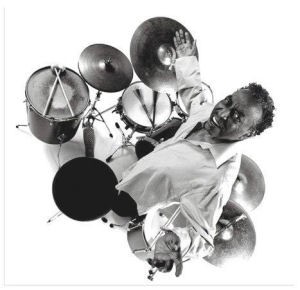 Even though ‘Blue Sands’ exclusively used toms it certainly wasn’t anything like the Latin-side of jazz which moved you to dance – it was much more of an orchestral fusion than that. I was knocked out by the subtle but clear sounds he coaxed out of the drums with his beaters, the hypnotic feel he produced and the way he was able to explore all the toms and still play so quietly. The image of what he was doing then has stayed with me for well over half a century.
Even though ‘Blue Sands’ exclusively used toms it certainly wasn’t anything like the Latin-side of jazz which moved you to dance – it was much more of an orchestral fusion than that. I was knocked out by the subtle but clear sounds he coaxed out of the drums with his beaters, the hypnotic feel he produced and the way he was able to explore all the toms and still play so quietly. The image of what he was doing then has stayed with me for well over half a century.
If anybody could be credited with inventing ‘West Coast Jazz’ (aka ‘Chamber Jazz’) the most likely contender has to be Chico Hamilton. He made his first record with Slim Gaillard but from 1955 to 2011 made more than sixty albums as a band leader and is generally accepted as being ’The Architect’ of that ‘cool jazz’ style.
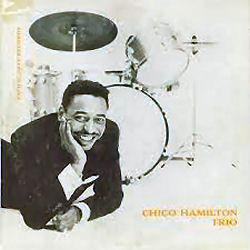 His own quintets were unusual in their instrumentations with cello and flute (something which he introduced to jazz) as well as guitar, bass (eventually) and of course drums. But long before all that he performed in LA’s Jefferson High School jazz band with no less than Dexter Gordon, Charles Mingus and Illinois Jacquet before turning professional at 19 with Lionel Hampton prior to a conscripted stint in the US Army in 1942 where he learned to read music with a chap called Billy Exner. In the piece I wrote about Sonny Greer I mentioned Chico was overawed by him (and his pyramid of drums) when he went with his mother as a youngster to see him playing with Duke Ellington. He decided then and there he was going to be a drummer and originally studied drums with Lee Young, who was Lester Young’s brother, before getting some help from Jo Jones. Mostly though he taught himself. When he began one bandleader refused to let him use anything other than brushes and this stood him in great stead while playing with singers. He evidently did this for 15 years and learned to lay down a groove but stay quiet underneath.
His own quintets were unusual in their instrumentations with cello and flute (something which he introduced to jazz) as well as guitar, bass (eventually) and of course drums. But long before all that he performed in LA’s Jefferson High School jazz band with no less than Dexter Gordon, Charles Mingus and Illinois Jacquet before turning professional at 19 with Lionel Hampton prior to a conscripted stint in the US Army in 1942 where he learned to read music with a chap called Billy Exner. In the piece I wrote about Sonny Greer I mentioned Chico was overawed by him (and his pyramid of drums) when he went with his mother as a youngster to see him playing with Duke Ellington. He decided then and there he was going to be a drummer and originally studied drums with Lee Young, who was Lester Young’s brother, before getting some help from Jo Jones. Mostly though he taught himself. When he began one bandleader refused to let him use anything other than brushes and this stood him in great stead while playing with singers. He evidently did this for 15 years and learned to lay down a groove but stay quiet underneath.
Chico Hamilton moved on to play with a very long list of jazz royalty including T-bone Walker, Charlie Barnett, Lester Young, Count Basie and Duke Ellington, Billy Eckstine, Nat King Cole, Sammy Davis jnr, Billie Holliday, Chet Baker and Gerry Mulligan to name but a few. A lot of gigs with these people came before his six year-long residency with Lena Horne which lasted until 1955.
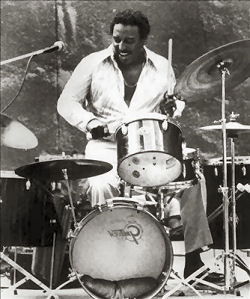 He was an extremely subtle musician who once said: “I’ve always seen the drums as a melodic instrument not a percussive one. I developed a touch – it may not be as loud but it’s mine!” I’m guessing that it was because of this philosophy that he persuaded the Gretsch drum company to make him drums with single heads in the sizes: 12 x 8, 14 x 12, 14 (or 16) x 18, with an 18 (or 20) x 14” bass and a 5.5” deep wood-shell snare drum (and though his 20” bass drum in the ‘Jazz On A Summer’s Day’ film has a front head on with the old curved Gretsch logo but Chico was a very early advocate of removing the resonance head on that drum too to flatten out its sound.) This single-headed thing evidently came about by accident because during the war he was unable to get calf-skin heads for his drums and if he broke a batter head he would simply replace it with the head on the bottom and this would of course make the drum sound more open. He began to like the sound it gave and once he got together with Gretsch, those were the sort of drums he asked them to make for him albeit with slightly deeper-than-normal shells.
He was an extremely subtle musician who once said: “I’ve always seen the drums as a melodic instrument not a percussive one. I developed a touch – it may not be as loud but it’s mine!” I’m guessing that it was because of this philosophy that he persuaded the Gretsch drum company to make him drums with single heads in the sizes: 12 x 8, 14 x 12, 14 (or 16) x 18, with an 18 (or 20) x 14” bass and a 5.5” deep wood-shell snare drum (and though his 20” bass drum in the ‘Jazz On A Summer’s Day’ film has a front head on with the old curved Gretsch logo but Chico was a very early advocate of removing the resonance head on that drum too to flatten out its sound.) This single-headed thing evidently came about by accident because during the war he was unable to get calf-skin heads for his drums and if he broke a batter head he would simply replace it with the head on the bottom and this would of course make the drum sound more open. He began to like the sound it gave and once he got together with Gretsch, those were the sort of drums he asked them to make for him albeit with slightly deeper-than-normal shells.
Chico was renowned for discovering young talent and Jim Hall, Gabor Szabo, Larry Coryell, Eric Dolphy and Ron Carter are on record as owing a big part of their careers to him.
 He was a successful film music writer (his many credits included Roman Polanski’s ‘Repulsion’) and from 1966 was responsible for literally hundreds of TV commercials and records and there’s even a documentary film about him called ‘Dancing To A Different Drummer’. He also made dance records like ‘Conquistadors’ and one of his instrumentals, called ‘Strut’, was evidently successful on the Northern Soul scene and even had its own dance!
He was a successful film music writer (his many credits included Roman Polanski’s ‘Repulsion’) and from 1966 was responsible for literally hundreds of TV commercials and records and there’s even a documentary film about him called ‘Dancing To A Different Drummer’. He also made dance records like ‘Conquistadors’ and one of his instrumentals, called ‘Strut’, was evidently successful on the Northern Soul scene and even had its own dance!
He embraced less jazzy sides of music too in the 21st Century recording with the likes of Jaimoe from the Allman brothers, Johnny Otis’s son Shuggie and Little Feat. Charlie Watts actually recorded with his hero Chico in 2001 on an album called ‘Foreststorne’ – there’s one track called ‘Here Comes Charlie Now’ which they played on together. This came about because in an interview with Charlie, Chico’s manager discovered that Chico’s quartet with Gerry Mulligan playing ‘Walking Shoes’ inspired him enough to call himself Chico Watts! This was more than enough for him to put them together in the studios.
Chico was also a vocalist and there’s evidence available of him on the internet singing: ‘Stompin At The Savoy’, ‘It Don’t Mean A Thing If It Ain’t Got That Swing’ and ‘Every Time I Smile’.
When asked by Rick Mattingly what were the favourite memories of his long career he replied: “That’s a difficult question to answer because I seldom look back. Life is one moment to the next so rather than looking back at what I did in the past, I’d rather look forward to the next time I can play!”
To get the essence of Chico Hamilton other than the tracks I’ve already mentioned at least check out ‘Under Paris Skies’, ‘Topsy’, ‘For Mods Only’ and ‘The Dealer’. Nobody made the ‘to 2’ part of a ‘10 to 2’ rhythm on the opening and closing hi hat last as long as Chico and nobody bounced the tip of the stick on the ride cymbal to create rhythm like him either. Listen to Conquistadores!
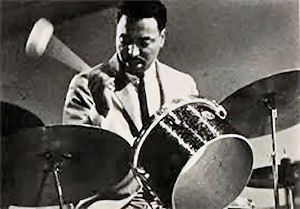 I know a lot of soon-to-be rockers went to see ‘Jazz On A Summer’s Day’ because, in a laudable attempt to put bums on seats at the Newport Festival by crossing the musical divide, somewhat incongruously Chuck Berry was booked to appear. He’s in the film singing ‘Sweet Little Sixteen’ and incredibly Chuck had the great Jo Jones playing drums with him. Jo, along with the rest of the proper jazz musicians in the pick-up band, looked completely mystified by what was going on!
I know a lot of soon-to-be rockers went to see ‘Jazz On A Summer’s Day’ because, in a laudable attempt to put bums on seats at the Newport Festival by crossing the musical divide, somewhat incongruously Chuck Berry was booked to appear. He’s in the film singing ‘Sweet Little Sixteen’ and incredibly Chuck had the great Jo Jones playing drums with him. Jo, along with the rest of the proper jazz musicians in the pick-up band, looked completely mystified by what was going on!
If you went to see the film for Chuck I’m guessing you’d have been pretty disappointed but for me and a lot of other early sixties drummers, the whole thing was absolutely electrifying – mostly because of Chico Hamilton and ‘Blue Sands’. Who knows, had it not been for Chico, Mick Fleetwood might not have given a thought to using beaters on Albatross and Nick Mason says he definitely wouldn’t have used them on ‘Set He Controls For The Heart Of The Sun’.)
Chico Hamilton was 92 when he died on November 23rd, 2013 but was still playing and even practising up until the end. When asked about why he was still practising at his age his response was: “I practise man. I’d better, there’s too many young players out there. I practise my instrument because I’m still learning how to play it!” He also talked about staying vital and playing drums at an advanced age saying: “I ain’t got nothing else to do!”
Bob Henrit
March 2014

